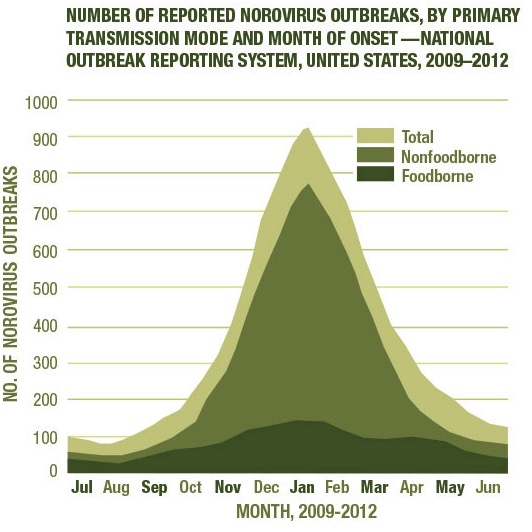Winter is bad enough. Long, dark, cold nights. Wind-chill factors. Digging out your car. Cabin fever. And, we have something else to "look forward to." A very tiny invader that causes a very large number of cases of a very unpleasant infection. Norovirus, aka "the stomach flu" (1) is also called the "winter vomiting disease." The name is quite accurate, as is shown on the CDC chart below, it hits full stride in December. And about 20 million Americans get it every year.

The distribution of norovirus outbreaks by month. Source: CDC
SAME OLD
Just like every winter, we are reading much of the usual advice. From the CDC:
- Wash your hands
Hand washing is still the best way to prevent transmission of the virus, but it can only do so much. It may stop you from giving it someone else, but it's not gonna prevent someone from giving it to you. Only 66% of Americans actually wash their hands after going to the bathroom, and only 30% use soap.

Photo: Checkup Newsroom
- Don't go to work sick
Great advice, except in the real world. Companies say that they want people to stay home when they're sick but workers in the foodservice industry - the primary cause of foodborne norovirus outbreaks - are poorly paid and may not be able to afford to take time off. They may also feel that their jobs will be threatened if they do. They probably are. Besides, while people are contagious for a few days after the illness, in some cases they can remain so for weeks.
- Disinfect surfaces
Easier said than done. Aside from being one of the most contagious viruses in the world, norovirus is also a tough little SOB. It laughs at alcohol. Bleach works, but only when the solution is rather concentrated (See Dirty Sheets: In Case You Need Another Reason To Stay Out Of The Hospital). And it can remain on surfaces for months, where the slobs who don't wash their hands can then touch it and then prepare your kale salad (2).
- Drink fluids
Easier said than done, especially when everything you swallow comes zooming up right away. But there is actually a medicine that can help. Zofran (generic name ondansetron), which was originally developed to treat chemotherapy-induced nausea and vomiting, has been shown to significantly reduce vomiting in children who were taken to the ER in as little as 15 minutes (1).
So, I thought I'd see if there is anything promising out there like a vaccine, drug, or sanitation method. The short answer is maybe, but not yet.
SOMETHING NEW. AND NASTY.
In case you think your job sucks, check this out. Scientists at Clemson University are studying new ways to clean up vomit. While this might not have me bounding out of bed in the morning to get to the lab it could be worse. At least they're not using the real thing. Instead (I kid you not) they are using a recipe for “simulated vomitus,” which was developed at the University of Chicago, to see which clean-up methods recommended by the CDC work best. Vomit recipes? Can you imagine the cookbook?

Original Image: Culinary Cellar
WHAT ABOUT RESEARCH?
Although norovirus used to be considered a nuisance, it is now being taken more seriously. Norovirus infection is not just unpleasant. Latest data from the CDC show that the bug results in 400,000 emergency department visits (primarily young children and the elderly), 56,000-71,000 hospitalizations and 570 to 800 deaths per year (primarily in the elderly). Worldwide, the situation is much worse. In 2015 the World Health Organization estimated that in 2015 there were 685 million cases worldwide (200 million of these were children) accounting for more than 200,000 deaths, almost exclusively in developing countries.
A norovirus vaccine has remained elusive, mostly because there are so many strains of the virus and it does not generate a strong immune response (3), but researchers at Vanderbilt University recently published the results of a study of Genotype II. Sydney 2012, the strain responsible for most outbreaks, in which James Crowe and colleagues isolated antibodies from patients who had been ill and found that they bound to three antigenic sites on the virus. This could pave way for a vaccine, although it won't be anytime soon.
There is no direct-acting antiviral drug (4) to treat or prevent norovirus infection. But Chimerix, a biotech in Durham, NC, is testing a small molecule (5) called CMX521 in Phase I trials. CMX521 targets an enzyme called RNA-dependent RNA (RdRp) polymerase (6), which is responsible for assembling the base pair units that will make up the genome needed to form new viruses. RdRp is present in all strains of the virus, so CMX521 is effective against multiple strains despite the fact that the surface protein binding sites (spikes) are different from strain to strain. Even though CMX521 works in isolated cells and mice it faces some challenges. For example, when do you take it? Before the bug hits you? After you start to feel sick? Will it work fast enough? These challenges are not trivial. Unless your family starts coming down with the bug, you will usually have no idea that it's going to get you. And once you begin to feel sick, the vomiting begins very quickly. A prophylactic antiviral is unusual.
I'm sorry to say that there isn't much difference between this norovirus season and last year's. Wash your hands. Wash someone else's hands. And pray.
NOTES:
(1) You don't even have to swallow it with water. Zofran comes in an orally dissolving tablet. It is placed on top of the tongue. Your body does the rest. It can also be placed under the tongue (sublingual absorption) and between the cheek and gum (buccal absorption). Both methods deliver the drug directly to the bloodstream.
(2) There are unconfirmed reports that kale produces symptoms that surpass those of norovirus. I cannot attest to this. I would rather eat gum off the floor of a subway car.
(3) You can get another infection soon after you're done with the first one. I believe this is the derivation of the expression "kill me."
(4) Direct acting antiviral drugs do what the name implies - they interfere with the replication of one step in the replication of the virus, thus stopping it cold. By contrast, some viral infections are treated with agents that ramp up the immune system (e.g., interferon).
(5) A "small molecule" is pretty much what the name implies - a molecule with a low molecular weight, usually 500 or less. Small molecules can (usually) be given as pills while large molecules (proteins, vaccines) cannot survive the conditions of the digestive tract or get absorbed into the blood. These are given by injection.
(6) The RdRp enzyme is common to RNA viruses. One of these is hepatitis C (HCV). The famous "$1,000 pill" Sovaldi, which was the first drug to efficiently cure hepatitis C patients worked by inhibiting HCV RdRp.




